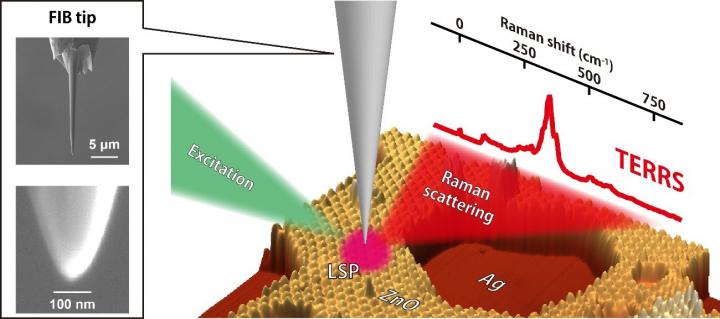'Resonance' raman spectroscopy with 1-nm resolution

Tip-enhanced resonance Raman scattering is measured by a silver tip fabricated by focused ion beam (FIB) milling. Localized surface plasmon (LSP) is excited by an excitation laser, which generates enhanced Raman scattering from ultrathin zinc oxide (ZnO) films grown on a single-crystal silver (Ag) surface. Credit: Takashi Kumagai
A research team at Fritz-Haber Institute in Berlin, headed by Dr. Takashi Kumagai, demonstrated tip-enhanced “resonance” Raman spectroscopy.
Resonance Raman spectroscopy is a powerful tool to analyze a specific chemical structure at a high sensitivity, but its spatial resolution has been restricted to be a few hundred nm due to the diffraction limit.
Extreme field confinement at a metal tip apex through localized surface plasmon excitation allows to break this limitation and now attain 1-nm resolution.
Tip-enhanced Raman spectroscopy takes advantage of atomic resolution imaging of scanning probe microscopy and enhanced Raman scattering through localized surface plasmon excitation.
The research team revealed tip-enhanced resonance Raman scattering in which both physical and chemical enhancement mechanisms are operative.
The underlying process was examined by modifying the localized surface plasmon resonance in the scanning tunneling microscope junction and by recording different-thickness zinc oxide films that exhibit a slightly different electronic structure.
In addition, the correlation between tip-enhanced resonance Raman scattering and local electronic states is resolved in combination with scanning tunneling spectroscopy that maps the local electronic state of the zinc oxide film.
The results explicitly show that a confined electromagnetic field can interact with local electronic resonances at the (sub)nanometer scale.
Media Contact
All latest news from the category: Physics and Astronomy
This area deals with the fundamental laws and building blocks of nature and how they interact, the properties and the behavior of matter, and research into space and time and their structures.
innovations-report provides in-depth reports and articles on subjects such as astrophysics, laser technologies, nuclear, quantum, particle and solid-state physics, nanotechnologies, planetary research and findings (Mars, Venus) and developments related to the Hubble Telescope.
Newest articles

Sea slugs inspire highly stretchable biomedical sensor
USC Viterbi School of Engineering researcher Hangbo Zhao presents findings on highly stretchable and customizable microneedles for application in fields including neuroscience, tissue engineering, and wearable bioelectronics. The revolution in…

Twisting and binding matter waves with photons in a cavity
Precisely measuring the energy states of individual atoms has been a historical challenge for physicists due to atomic recoil. When an atom interacts with a photon, the atom “recoils” in…

Nanotubes, nanoparticles, and antibodies detect tiny amounts of fentanyl
New sensor is six orders of magnitude more sensitive than the next best thing. A research team at Pitt led by Alexander Star, a chemistry professor in the Kenneth P. Dietrich…





















